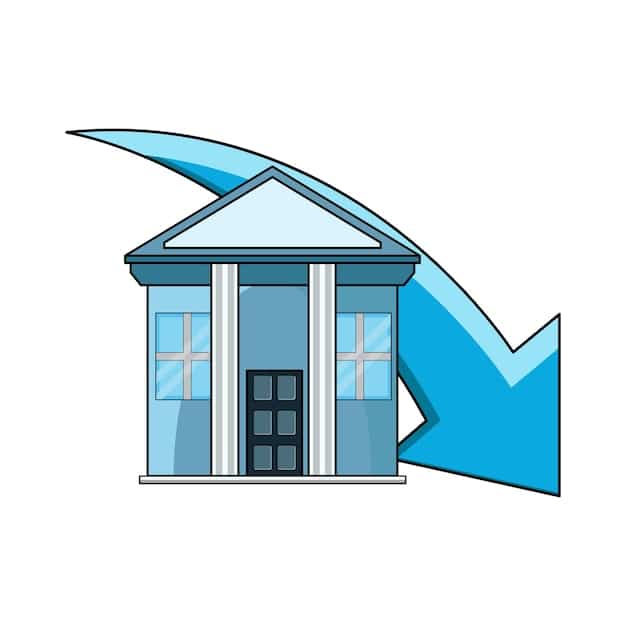The Federal Reserve: Navigating Inflation and Interest Rates

Understanding the Role of the Federal Reserve in Managing Inflation and Interest Rates involves using monetary policy tools, such as adjusting the federal funds rate and reserve requirements, to stabilize prices and promote maximum employment in the U.S. economy.
Navigating the complexities of the U.S. economy often requires understanding the actions of the Federal Reserve. Understanding the Role of the Federal Reserve in Managing Inflation and Interest Rates is crucial, as its decisions impact everything from mortgage rates to the price of groceries. Let’s delve into how the Fed operates and why its policies matter to you.
The Federal Reserve: An Overview of Its Mandate
The Federal Reserve, often referred to as the Fed, is the central bank of the United States. It plays a critical role in ensuring the stability and health of the nation’s economy. But what exactly does the Fed do, and what are its primary objectives?
The Fed’s main mandate, as defined by Congress, includes promoting maximum employment, stable prices, and moderate long-term interest rates. Achieving these goals requires a delicate balancing act and a deep understanding of economic forces.
The Dual Mandate: Employment and Price Stability
The Fed operates under what is known as a dual mandate. This means it has two co-equal objectives: maximizing employment and maintaining price stability. These two goals are interconnected and often influence each other.
Maximum employment refers to a situation where as many people as possible who are willing and able to work can find jobs. Price stability, on the other hand, means keeping inflation at a manageable level.
The Structure of the Federal Reserve System
The Federal Reserve System is composed of several key entities working together to achieve its goals. Understanding its structure is essential for grasping how the Fed operates.
- Board of Governors: The governing body of the Federal Reserve System, consisting of seven members appointed by the President of the United States.
- Federal Open Market Committee (FOMC): The FOMC is responsible for setting monetary policy, including the federal funds rate.
- Twelve Federal Reserve Banks: These regional banks oversee the activities of member banks in their districts and provide various financial services.
In conclusion, the Federal Reserve’s mandate is to promote a healthy economy through maximum employment and stable prices. Its structure, comprising the Board of Governors, FOMC, and regional banks, ensures a comprehensive approach to monetary policy.
Understanding Inflation: Causes and Consequences
Inflation is a key economic indicator that affects the cost of goods and services. Understanding the Role of the Federal Reserve in Managing Inflation and Interest Rates is essential because inflation directly influences purchasing power and economic stability. But what causes inflation, and what are its consequences?
Inflation refers to the rate at which the general level of prices for goods and services is rising, and subsequently, purchasing power is falling. It is a natural part of economic cycles but can become problematic if left unchecked.

Causes of Inflation
Inflation can be triggered by various factors, often categorized into demand-pull and cost-push inflation. Understanding these causes is crucial for effective policy responses.
Demand-pull inflation occurs when there is an increase in aggregate demand that outstrips the available supply of goods and services. This can happen due to increased consumer spending, government expenditures, or export demand.
Cost-push inflation, on the other hand, arises when the costs of production, such as wages and raw materials, increase. This leads to businesses raising prices to maintain profitability.
Consequences of Inflation
While a small amount of inflation is considered healthy for an economy, high or uncontrolled inflation can have several negative consequences.
- Reduced Purchasing Power: As prices rise, each dollar buys fewer goods and services, reducing consumers’ purchasing power.
- Uncertainty and Investment: High inflation can create uncertainty, discouraging businesses from making long-term investments.
- Income Redistribution: Inflation can redistribute income from creditors to debtors, as the real value of debt decreases.
In summary, inflation is driven by demand-pull and cost-push factors and can lead to reduced purchasing power and economic uncertainty. The Federal Reserve closely monitors inflation and uses its tools to keep it within a target range.
The Federal Funds Rate: A Key Tool for Controlling Inflation
The federal funds rate is one of the primary tools the Federal Reserve uses to influence economic activity, especially to manage inflation. Understanding the Role of the Federal Reserve in Managing Inflation and Interest Rates involves grasping how this rate works and its impact on the broader economy.
The federal funds rate is the target rate that the FOMC wants banks to charge one another for the overnight lending of reserves. By influencing this rate, the Fed can affect other interest rates throughout the economy.
How the Federal Funds Rate Works
The Fed does not directly set the federal funds rate. Instead, it uses open market operations to influence the supply of reserves in the banking system.
When the Fed wants to lower the federal funds rate, it buys government securities from banks, injecting reserves into the banking system. This increases the supply of reserves, putting downward pressure on the rate.
Conversely, when the Fed wants to raise the federal funds rate, it sells government securities to banks, draining reserves from the banking system. This reduces the supply of reserves, putting upward pressure on the rate.
Impact on Borrowing Costs
Changes in the federal funds rate have a ripple effect throughout the economy, affecting various borrowing costs.
- Mortgage Rates: When the federal funds rate rises, mortgage rates typically increase, making it more expensive to buy a home.
- Credit Card Rates: Credit card interest rates often follow the federal funds rate, affecting the cost of borrowing for consumers.
- Business Loans: Businesses also face higher borrowing costs when the federal funds rate increases, potentially slowing down investment and expansion.
In conclusion, the federal funds rate is a critical tool for the Federal Reserve to manage inflation. By influencing the supply of reserves, the Fed can affect borrowing costs and economic activity.
Other Monetary Policy Tools: Reserve Requirements and Quantitative Easing
While the federal funds rate is a primary tool, the Federal Reserve also uses other monetary policy instruments to influence the economy. These include reserve requirements and quantitative easing. Understanding the Role of the Federal Reserve in Managing Inflation and Interest Rates involves knowing how these tools complement the federal funds rate.
Reserve requirements refer to the amount of money that banks must hold in reserve against deposits. Quantitative easing (QE) is a more unconventional tool used to stimulate the economy during periods of low inflation or recession.
Reserve Requirements
Reserve requirements can impact the amount of money that banks have available to lend, influencing credit availability and economic activity.
When the Fed lowers reserve requirements, banks have more money to lend, which can stimulate economic growth. Raising reserve requirements, on the other hand, reduces the amount of money available for lending, potentially slowing down the economy.
Quantitative Easing (QE)
QE involves the Fed purchasing longer-term government securities or other assets to inject liquidity into the market and lower long-term interest rates.
- Lowering Long-Term Rates: QE can help lower long-term interest rates, encouraging borrowing and investment.
- Signaling Commitment: QE can also signal the Fed’s commitment to supporting the economy, boosting confidence.
- Impact on Asset Prices: QE can lead to higher asset prices, such as stocks and real estate, increasing wealth and stimulating spending.
In summary, reserve requirements and quantitative easing are additional tools the Federal Reserve uses to influence economic activity. These tools can complement the federal funds rate in managing inflation and promoting economic growth.

The Fed’s Response to Economic Shocks: Past and Present
Economic shocks, such as recessions or financial crises, often require the Federal Reserve to take decisive action. Understanding the Role of the Federal Reserve in Managing Inflation and Interest Rates involves examining how the Fed has responded to past economic challenges.
The Fed’s response to economic shocks typically involves a combination of interest rate adjustments, liquidity provision, and, in some cases, unconventional measures like QE.
Historical Examples
Looking at historical examples can provide valuable insights into how the Fed operates during times of crisis.
During the 2008 financial crisis, the Fed aggressively lowered the federal funds rate to near zero and implemented several rounds of QE to stabilize financial markets and support the economy.
Similarly, during the COVID-19 pandemic, the Fed quickly lowered interest rates and launched massive QE programs to cushion the economic blow and promote recovery.
Current Challenges and Strategies
Today, the Fed faces new challenges, including rising inflation and global economic uncertainty. Its strategies to address these challenges are closely watched by markets and economists.
The Fed is currently focused on gradually raising interest rates and reducing its balance sheet to combat inflation while trying to avoid triggering a recession. This balancing act requires careful calibration and monitoring of economic data.
In conclusion, the Federal Reserve’s response to economic shocks is crucial for maintaining stability. By learning from past experiences and adapting its strategies to current challenges, the Fed plays a vital role in steering the economy through turbulent times.
Challenges and Criticisms of the Federal Reserve
While the Federal Reserve plays a critical role in managing the U.S. economy, it also faces numerous challenges and criticisms. Understanding the Role of the Federal Reserve in Managing Inflation and Interest Rates requires acknowledging these concerns, which range from issues of transparency to debates over policy effectiveness.
Critics often argue that the Fed’s actions can have unintended consequences and that its policies may disproportionately benefit certain groups or sectors of the economy.
Transparency and Accountability
One of the key criticisms of the Federal Reserve is a perceived lack of transparency and accountability. Some argue that the Fed operates with too much secrecy, making it difficult for the public to understand its decisions.
Others contend that the Fed’s independence from political influence is essential for its effectiveness and that greater transparency could compromise its ability to act decisively.
Policy Effectiveness
The effectiveness of the Fed’s policies is also a subject of ongoing debate. Some argue that the Fed’s tools are limited and that it has little control over factors such as fiscal policy or global economic conditions.
- Unintended Consequences: Critics point to instances where the Fed’s policies have had unintended consequences, such as asset bubbles or increased income inequality.
- Limited Control: Others argue that the Fed’s ability to influence the economy is constrained by factors beyond its control, such as consumer confidence or international trade.
In summary, the Federal Reserve faces challenges related to transparency, accountability, and policy effectiveness. Addressing these concerns is crucial for maintaining public trust and ensuring that the Fed’s actions promote broad-based economic prosperity.
The Future of Monetary Policy: Innovations and Trends
The landscape of monetary policy is constantly evolving, driven by technological advancements, changing economic structures, and new challenges. Understanding the Role of the Federal Reserve in Managing Inflation and Interest Rates in the future requires considering emerging trends and innovations in monetary policy.
One notable trend is the increasing use of digital currencies and blockchain technology, which could potentially disrupt traditional financial systems.
Digital Currencies and Blockchain
The rise of digital currencies, including central bank digital currencies (CBDCs) and private cryptocurrencies like Bitcoin, presents both opportunities and challenges for monetary policy.
CBDCs could potentially improve the efficiency of payments and reduce transaction costs. However, they also raise questions about privacy, security, and the role of central banks in the digital age.
New Policy Frameworks
Central banks around the world are also exploring new policy frameworks to better address the challenges of low inflation and low interest rates.
- Average Inflation Targeting: Some central banks have adopted average inflation targeting, which allows inflation to temporarily exceed the target to make up for past shortfalls.
- Nominal GDP Targeting: Another approach is nominal GDP targeting, which focuses on achieving a specific level of nominal GDP growth, taking into account both inflation and real output.
In conclusion, the future of monetary policy is likely to be shaped by digital currencies, new policy frameworks, and other innovations. Navigating these changes will require the Federal Reserve to be adaptable and forward-thinking.
| Key Concept | Brief Description |
|---|---|
| 🏢 Federal Reserve | Central bank of the U.S. responsible for monetary policy. |
| 📈 Inflation Management | Using tools to keep inflation at a stable and desirable level. |
| 🏦 Federal Funds Rate | Interest rate banks charge each other for overnight lending of reserves. |
| 💰 Quantitative Easing | Purchase of government securities to increase money supply. |
Frequently Asked Questions
▼
The Federal Reserve aims to promote maximum employment and stable prices in the U.S. economy, often referred to as its dual mandate.
▼
The Fed primarily controls inflation by adjusting the federal funds rate, which influences borrowing costs and overall economic activity.
▼
The federal funds rate is the interest rate at which banks lend reserves to each other overnight. It serves as a benchmark for other interest rates.
▼
QE involves the Fed purchasing long-term government securities to inject liquidity into the market and lower long-term interest rates.
▼
The Fed typically responds to recessions by lowering interest rates, providing liquidity, and sometimes implementing unconventional measures like QE.
Conclusion
In conclusion, understanding the role of the Federal Reserve in managing inflation and interest rates is essential for anyone looking to grasp the dynamics of the U.S. economy. The Fed’s actions have far-reaching consequences, impacting everything from borrowing costs to employment levels. By monitoring its policies and understanding its objectives, individuals and businesses can make more informed decisions and better navigate the economic landscape.





